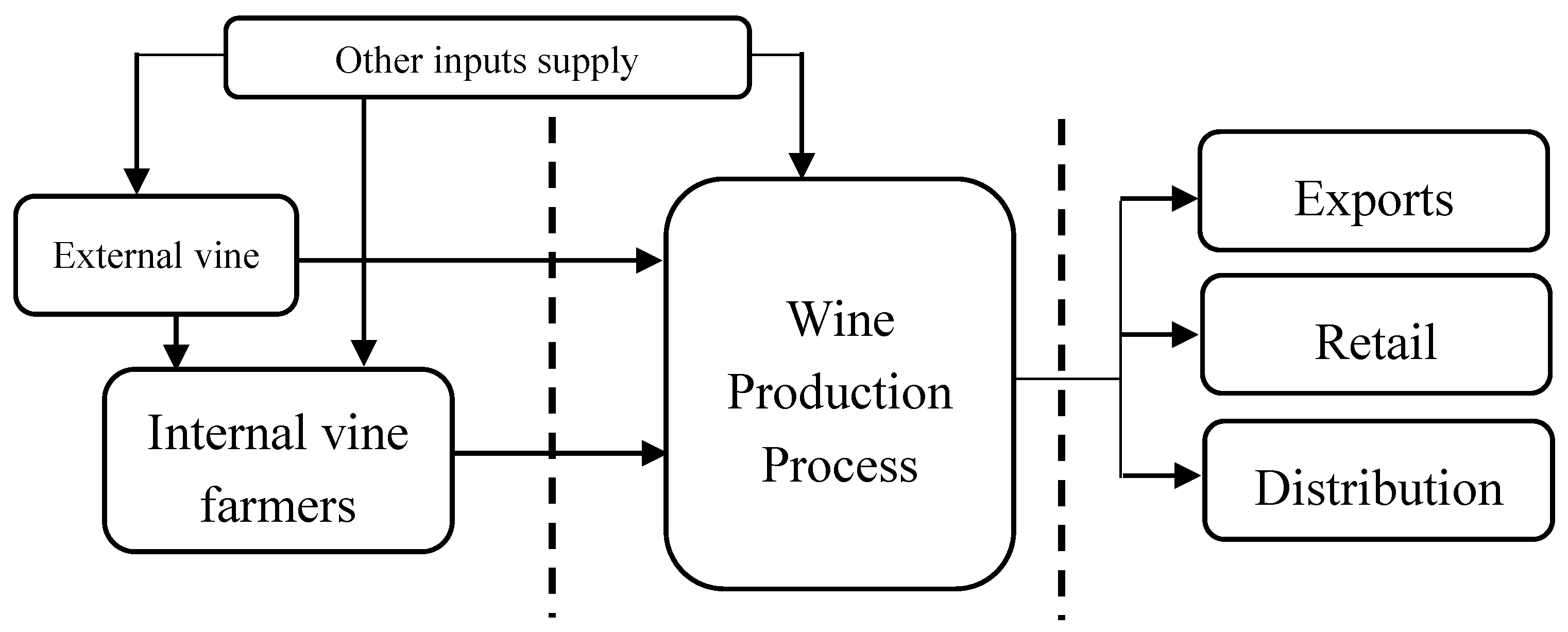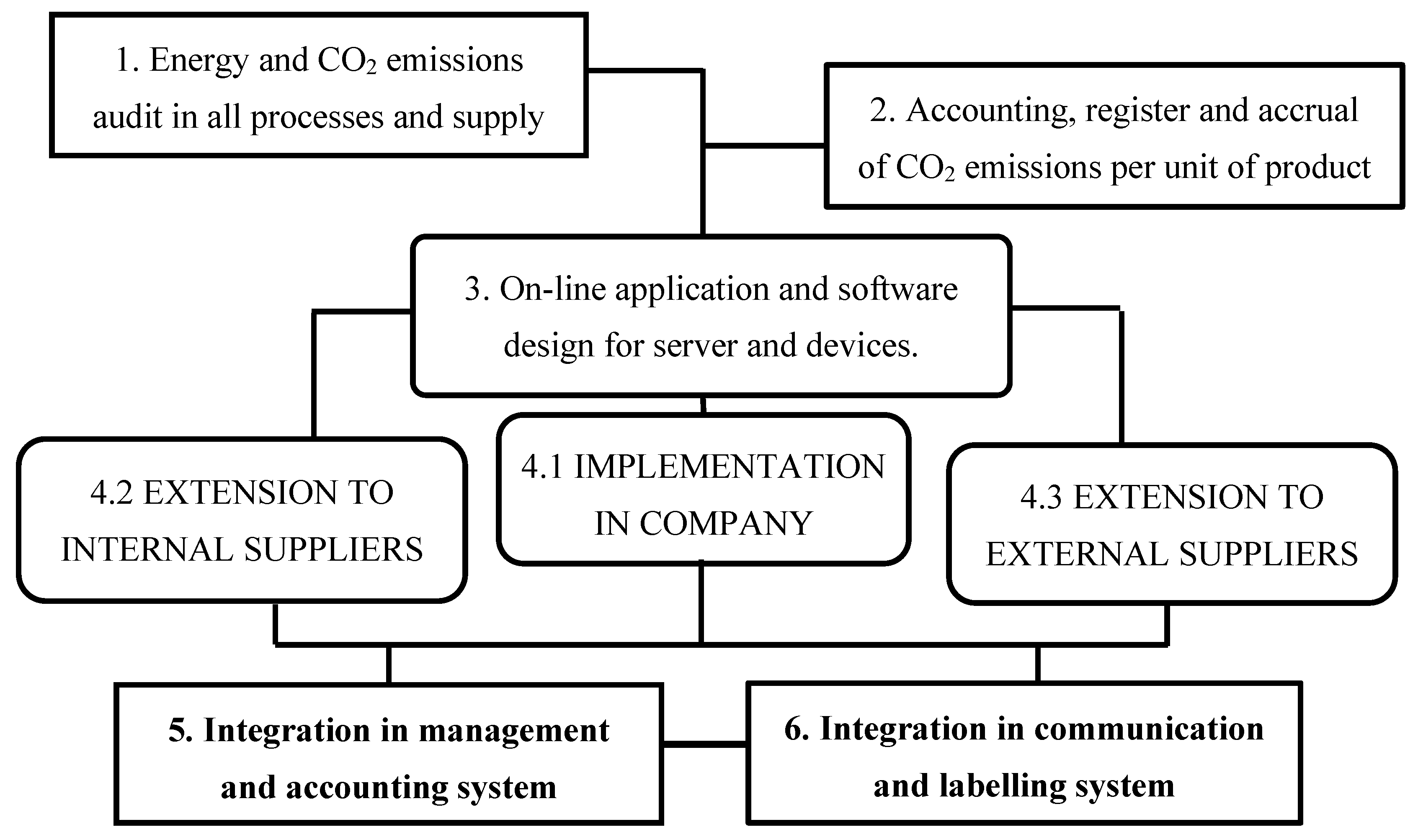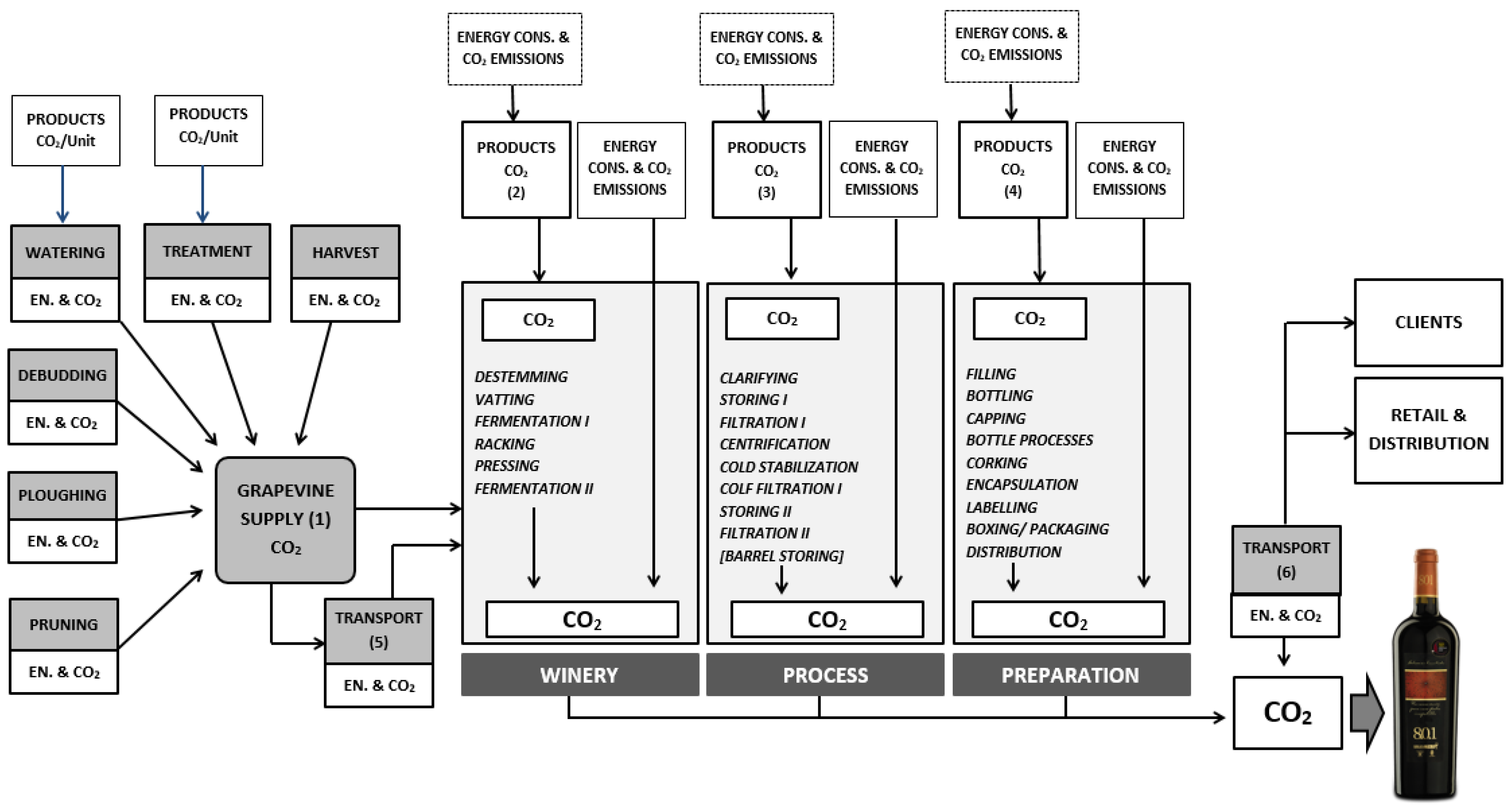Accounting for Carbon Footprint Flows in Wine Production Process. Case Study in Spanish Winery
Abstract
:1. Introduction
2. Background
2.1. Material Flow Cost Accounting
2.2. Carbon Emissions in the Wine Industry
3. Case Study
3.1. Methods
3.2. Results and Outcomes
3.3. Discussion
4. Conclusions
Author Contributions
Funding
Conflicts of Interest
References
- Baumast, A.; Pape, J. (Eds.) Betriebliches Nachhaltigkeitsmanagement, 1st ed.; Eugen Ulmer: Stuttgart, Germany, 2013. [Google Scholar]
- Nakajima, M.; Kimura, A.; Wagner, B. Introduction of material flow cost accounting (MFCA) to the supply chain: A questionnaire study on the challenges of constructing a low-carbon supply chain to promote resource efficiency. J. Clean. Prod. 2015, 108, 1302–1309. [Google Scholar] [CrossRef]
- Dierkes, S.; Siepelmeyer, D. Production and cost theory-based material flow cost accounting. J. Clean. Prod. 2019, 235, 483–492. [Google Scholar] [CrossRef]
- Christ, K.L.; Burritt, R.L. Material flow cost accounting: A review and agenda for future research. J. Clean. Prod. 2015, 108, 1378–1389. [Google Scholar] [CrossRef]
- Cooper, R.; Slagmulder, R. Supply Chain Development for the Lean Enterprise e Inter-organizational Cost Management; Deselnicu, O.C., Ed.; Productivity, Inc.: Plymouth, MN, USA, 1999. [Google Scholar]
- Ruggieri, L.; Cadena, E.; Martínez-Blanco, J.; Gasol, C.M.; Rieradevall, J.; Gabarrell, X.; Gea, T.; Sort, X.; Sánchez, A. Recovery of organic wastes in the Spanish wine industry. Technical, economic and environmental analyses of the composting process. J. Clean. Prod. 2009, 17, 830–838. [Google Scholar] [CrossRef] [Green Version]
- Bisson, L.F.; Waterhouse, A.L.; Ebeler, S.E.; Walker, M.A.; Lapsley, J.T. The present and future of the international wine industry. Nat. Cell Biol. 2002, 418, 696–699. [Google Scholar] [CrossRef]
- Cordano, M.; Marshall, R.S.; Silverman, M. How do Small and Medium Enterprises Go “Green”? A Study of Environmental Management Programs in the U.S. Wine Industry. J. Bus. Ethics 2010, 92, 463–478. [Google Scholar] [CrossRef]
- Christ, K.L.; Burritt, R.L. Critical environmental concerns in wine production: An integrative review. J. Clean. Prod. 2013, 53, 232–242. [Google Scholar] [CrossRef]
- Notarnicola, B.; Tassielli, G.; Nicoletti, G.M. Life cycle assessment (LCA) of wine production. In Environmentally-Friendly Food Processing; Mattson, B., Sonesson, U., Eds.; Woodhead Publishing Ltd.: Cambridge, UK, 2003; pp. 306–326. [Google Scholar]
- Mujica, M.; Blanco, G.; Santalla, E. Carbon footprint of honey produced in Argentina. J. Clean. Prod. 2016, 116, 50–60. [Google Scholar] [CrossRef]
- Lamastra, L.; Suciu, N.A.; Novelli, E.; Trevisan, M. A new approach to assessing the water footprint of wine: An Italian case study. Sci. Total Environ. 2014, 490, 748–756. [Google Scholar] [CrossRef] [PubMed]
- Herath, H.M.I.K.; Green, S.; Singh, R.; Horne, D.; Van Der Zijpp, S.; Clothier, B. Water footprinting of agricultural products: A hydrological assessment for the water footprint of New Zealand’s wines. J. Clean. Prod. 2013, 41, 232–243. [Google Scholar] [CrossRef]
- Herath, H.M.I.K.; Green, S.; Horne, D.; Singh, R.; McLaren, S.J.; Clothier, B. Water footprinting of agricultural products: Evaluation of different protocols using a case study of New Zealand wine. J. Clean. Prod. 2013, 44, 159–167. [Google Scholar] [CrossRef]
- Vázquez-Rowe, I.; Rugani, B.; Benetto, E. Tapping carbon footprint variations in the European wine sector. J. Clean. Prod. 2013, 43, 146–155. [Google Scholar] [CrossRef]
- Santalla, E.; Córdoba, V.; Blanco, G. Greenhouse gas emissions from the waste sector in Argentina in business-as-usual and mitigation scenarios. J. Air Waste Manag. Assoc. 2013, 63, 909–917. [Google Scholar] [CrossRef] [PubMed] [Green Version]
- Point, E.; Tyedmers, P.; Naugler, C. Life cycle environmental impacts of wine production and consumption in Nova Scotia, Canada. J. Clean. Prod. 2012, 27, 11–20. [Google Scholar] [CrossRef]
- Aranda, A.; Zabalza, I.; Scarpellini, S. Economic and environmental analysis of the wine bottle production in Spain by means of life cycle assessment. Int. J. Agric. Resour. Gov. Ecol. 2005, 4, 178–191. [Google Scholar] [CrossRef]
- Nowak, L.I.; Washburn, J.H. Building Brand Equity: Consumer Reactions to Proactive Environmental Policies by the Winery. Int. J. Wine Mark. 2002, 14, 5–19. [Google Scholar] [CrossRef]
- Navarro, A.; Puig, R.; Kılıç, E.; Penavayre, S.; Fullana-I-Palmer, P. Eco-innovation and benchmarking of carbon footprint data for vineyards and wineries in Spain and France. J. Clean. Prod. 2017, 142, 1661–1671. [Google Scholar] [CrossRef]
- Frigon, A.; Doloreux, D.; Shearmur, R. Drivers of eco-innovation and conventional innovation in the Canadian wine industry. J. Clean. Prod. 2020, 275, 124115. [Google Scholar] [CrossRef]
- Smith, D.M. Sustainable viticulture and winery practices in California: What is it, and do customers care? Int. J. Wine Res. 2009, 189. [Google Scholar] [CrossRef] [Green Version]
- Bastianoni, S.; Donati, A.; Piccini, A. How to Measure the Sustainability of an Area? The SPIn-Eco Project and the Sustainability of the Province of Siena. In Transactions on Ecology and the Environment Vol 63; WIT Press, 2003; ISSN 1743-3541. Available online: www.witpress.com (accessed on 25 November 2020).
- Kokubu, K.; Tachikawa, H. Material flow cost accounting: Significance and practical approach. In Handbook of Sustainable Engineering; Kauffman, J., Lee, K.-M., Eds.; Springer: Dordrecht, The Netherlands, 2013; pp. 351–369. [Google Scholar]
- Lang, C.; Heubach, D.; Loew, T. Using software systems to support environmental accounting instruments. In Implementing Environmental Management Accounting; Rikhardsson, P.M., Bennett, M., Bouma, J.J., Schaltegger, S., Eds.; Springer: Berlin/Heidelberg, Germany, 2005; pp. 143–168. [Google Scholar]
- International Organization for Standardization (ISO). ISO 14051: Environmental Management: Material Flow Cost Accounting: General Framework; International Organization for Standardization: Geneva, Switzerland, 2011. [Google Scholar]
- Prox, M. Material Flow Cost Accounting Extended to the Supply Chain – Challenges, Benefits and Links to Life Cycle Engineering. Procedia CIRP 2015, 29, 486–491. [Google Scholar] [CrossRef]
- Jasch, C. Environmental management accounting: Comparing and linking requirements at micro and macro levels e a practitioner’s view. In Environmental Management Accounting and Supply Chain Managemen; Burritt, R.L., Schaltegger, S., Bennett, M., Pohjola, T., Csutora, M., Eds.; Springer: Berlin/Heidelberg, Germany, 2011; pp. 255–277. [Google Scholar]
- Scavone, G.M. Challenges in internal environmental management reporting in Argentina. J. Clean. Prod. 2006, 14, 1276–1285. [Google Scholar] [CrossRef]
- Günther, E.; Rieckhof, R.; Schrack, D.; Walz, M. Materialflusskostenrechnung im Lichte eines klassischen Kostenrechnungsverständnisses e versuch einer Annäherung. In Nachhaltiges Entscheiden e Beitr€age zum Multiperspektivischen Performancemanagement von Wertschöpfungsprozessen; Ahn, H., Clermont, M., Sourcen, R., Eds.; Springer Gabler: Wiesbaden, Germany, 2016; pp. 149–174. [Google Scholar]
- Ene, S.A.; Teodosiu, C.; Robu, B.; Volf, I. Water footprint assessment in the winemaking industry: A case study for a Romanian medium size production plant. J. Clean. Prod. 2013, 43, 122–135. [Google Scholar] [CrossRef]
- Pawsey, N. Water Management Accounting and the Wine Supply Chain: Empirical Evidence from Australia. Soc. Environ. Account. J. 2015, 35, 195. [Google Scholar] [CrossRef]
- Christ, K.L. Water management accounting and the wine supply chain: Empirical evidence from Australia. Br. Account. Rev. 2014, 46, 379–396. [Google Scholar] [CrossRef]
- Arzoumanidis, I.; Fullana-I-Palmer, P.; Raggi, A.; Gazulla, C.; Raugei, M.; Benveniste, G.; Anglada, M. Unresolved issues in the accounting of biogenic carbon exchanges in the wine sector. J. Clean. Prod. 2014, 82, 16–22. [Google Scholar] [CrossRef]
- Bosco, S.; Di Bene, C.; Galli, M.; Remorini, D.; Massai, R.; Bonari, E. Soil organic matter accounting in the carbon footprint analysis of the wine chain. Int. J. Life Cycle Assess. 2013, 18, 973–989. [Google Scholar] [CrossRef]
- Hoekstra, A.Y.; Chapagain, A.K.; Aldaya, M.M.; Mekonnen, M.M. The Water Footprint Assessment Manual: Setting the Global Standard; Water Footprint Network; Earthscan Publishing: London, UK, 2011. [Google Scholar]
- Neto, B.; Dias, A.C.; Machado, M. Life cycle assessment of the supply chain of a Portuguese wine: From viticulture to distribution. Int. J. Life Cycle Assess. 2012, 18, 590–602. [Google Scholar] [CrossRef]
- Quinteiro, P.; Dias, A.C.; Pina, L.; Neto, B.; Ridoutt, B.G.; Arroja, L. Addressing the freshwater use of a Portuguese wine (‘vinho verde’) using different LCA methods. J. Clean. Prod. 2014, 68, 46–55. [Google Scholar] [CrossRef]
- Villanueva-Rey, P.; Vázquez-Rowe, I.; Otero, M.; Moreira, M.T.; Feijoo, G. Accounting for time-dependent changes in GHG emissions in the Ribeiro appellation (NW Spain): Are land use changes an important driver? Environ. Sci. Policy 2015, 51, 215–227. [Google Scholar] [CrossRef]
- Niccolucci, V.; Galli, A.; Kitzes, J.; Pulselli, R.M.; Borsa, S.; Marchettini, N. Ecological Footprint analysis applied to the production of two Italian wines. Agric. Ecosyst. Environ. 2008, 128, 162–166. [Google Scholar] [CrossRef]
- Rugani, B.; Vázquez-Rowe, I.; Benedetto, G.; Benetto, E. A comprehensive review of carbon footprint analysis as an extended environmental indicator in the wine sector. J. Clean. Prod. 2013, 54, 61–77. [Google Scholar] [CrossRef]
- Quezada, R.; Hsieh, T.; Valderrama, J.O. Determination of the carbon footprint using the method composed of financial accounts (MC3) for a wine company in Chile. Inf. Tecnol. 2013, 24, 3–14. [Google Scholar] [CrossRef] [Green Version]
- Viers, J.H.; Williams, J.N.; Nicholas, K.A.; Barbosa, O.; Kotzé, I.; Spence, L.; Webb, L.B.; Merenlender, A.; Reynolds, M. Vinecology: Pairing wine with nature. Conserv. Lett. 2013, 6, 287–299. [Google Scholar] [CrossRef]
- Bosco, S.; Di Bene, C.; Galli, M.; Remorini, D.; Massai, R.; Bonari, E. Greenhouse gas emissions in the agricultural phase of wine production in the Maremma rural district in Tuscany, Italy. Ital. J. Agron. 2011, 6, 93–100. [Google Scholar] [CrossRef]
- Benedetto, G.; Rugani, B.; Vázquez-Rowe, I. Rebound effects due to economic choices when assessing the environmental sustainability of wine. Food Policy 2014, 49, 167–173. [Google Scholar] [CrossRef]
- Marco, M.; Moneva, J.M.; Scarpellini, S. Environmental disclosure and eco-innovation interrelation. The case of Spanish firms. Span. Account. Rev. 2019, 22, 71–85. [Google Scholar]
- Radu, A.L.; Olaru, O.; Dimitriu-Caracota, M.; Banacu, C.S. Ecological footprint analysis: Towards a projects evaluation model for promoting sustainable development. Vision 2020: Innovation, Development Sustainability, and Economic Growth. In Proceedings of the 21st International Business Information Management Association Conference, IBIMA, Vienna, Austria, 27–28 June 2013; Volume 2, pp. 399–407. [Google Scholar]
- Lesschaeve, I.; Bowen, A.; Bruwer, J. Determining the Impact of Consumer Characteristics to Project Sensory Preferences in Commercial White Wines. Am. J. Enol. Vitic. 2012, 63, 487–493. [Google Scholar] [CrossRef]
- Burritt, R.; Schaltegger, S. Eco-efficiency in corporate budgeting. Environ. Manag. Heal. 2001, 12, 158–174. [Google Scholar] [CrossRef] [Green Version]
- Stechemesser, K.; Guenther, E. Carbon accounting: A systematic literature review. J. Clean. Prod. 2012, 36, 17–38. [Google Scholar] [CrossRef]
- Bonamente, E.; Scrucca, F.; Asdrubali, F.; Cotana, F.; Presciutti, A. The water footprint of the wine industry: Implementation of an assessment methodology and application to a case study. Sustainability 2015, 7, 12190–12208. [Google Scholar] [CrossRef] [Green Version]
- Viana, R.C.; Rodrigues, L.L. A special accounting treatment for regulated industries? The case of the port wine industry. J. Wine Res. 2006, 17, 11–34. [Google Scholar] [CrossRef]
- Aparicio, J.; Borras, F.; Pastor, J.T.; Vidal, F. Accounting for slacks to measure and decompose revenue efficiency in the Spanish Designation of Origin wines with DEA. Eur. J. Oper. Res. 2013, 231, 443–451. [Google Scholar] [CrossRef]
- Van der Zanden, G.J. The Truth about CO2 Emissions in the Wine Industry. Viña De Martino, Reinventing Chile, CHILE 2009. Available online: http://www.txb-finewines.com/upload/The_truth_about_CO2_emissions_in_the_wine_industry_April_2009_223.pdf (accessed on 25 November 2020).
- Casini, L.; Marone, E.; Scozzafava, G. Management accounting in the winegrowing sector: Proposal and development of an “Ad Hoc” control system. Qual. Access Success 2014, 15, 70–73. [Google Scholar]
- Scrucca, F.; Bonamente, E.; Rinaldi, S. Carbon footprint in the wine industry. In Environmental Carbon Footprints: Industrial Case Studies; Elsevier: Amsterdam, The Netherlands, 2017; pp. 161–196. [Google Scholar] [CrossRef]
- Rinaldi, S.; Bonamente, E.; Scrucca, F.; Merico, M.C.; Asdrubali, F.; Cotana, F. Water and Carbon Footprint of Wine: Methodology Review and Application to a Case Study. Sustainability 2016, 8, 621. [Google Scholar] [CrossRef] [Green Version]
- Trombly, A.J.; Fortier, M.P. Carbon Footprint of Wines from the Finger Lakes Region in New York State. Sustainability 2019, 11, 2945. [Google Scholar] [CrossRef] [Green Version]



| Phase 1 | Characterize the company value chain from a Life Cycle Analysis approach, auditing energy consumption and equivalent CO2 emissions in all processes linked to the product, in production process and supply chain. |
| Phase 2 | Linkage and accrual of aggregate CO2 emissions equivalent to the final production, obtaining the volume of emissions per unit applicable to each final product unit (bottle/wine box). |
| Phase 3 | Development of an interactive online application integrating all factors of the supply and production chain, allowing for real-time accounting and analysis of CO2 emissions. |
| Phase 4 | System implementation, (1) incorporating the company technical staff, (2) cooperative farmers and (3) representatives of the rest of the supply chain. Training and practice on the use and management of the application. |
| Phase 5 | Complete integration of the application in the integrated management and accounting system of the company, permitting the automatically linkage of CO2 emissions with other systems such as financial accounting, product card, vendor card, etc. |
| Phase 6 | Reporting of results in the communication and corporate information system, as well as the wine labelling process. Public communication of aggregated emissions and volume of emissions per bottle (or unit sold) on product label. |
| Year 1—CO2 eq. | Year 2—CO2 eq. | Change in % | |
|---|---|---|---|
| CF for the company and its supply chain | 12.734 tons | 10.224 tons | −19.71% |
| Average CF per unit of product (in Kg/L) | 0.828 kg/L | 0.795 kg/L | −3.98% |
| Average CF per 0.75 L bottle (estimated) | 0.755 kg/bottle | 0.731 kg/bottle | −3.28% |
Publisher’s Note: MDPI stays neutral with regard to jurisdictional claims in published maps and institutional affiliations. |
© 2020 by the authors. Licensee MDPI, Basel, Switzerland. This article is an open access article distributed under the terms and conditions of the Creative Commons Attribution (CC BY) license (http://creativecommons.org/licenses/by/4.0/).
Share and Cite
Marco-Fondevila, M.; Moneva, J.M.; Llena-Macarulla, F. Accounting for Carbon Footprint Flows in Wine Production Process. Case Study in Spanish Winery. Appl. Sci. 2020, 10, 8381. https://doi.org/10.3390/app10238381
Marco-Fondevila M, Moneva JM, Llena-Macarulla F. Accounting for Carbon Footprint Flows in Wine Production Process. Case Study in Spanish Winery. Applied Sciences. 2020; 10(23):8381. https://doi.org/10.3390/app10238381
Chicago/Turabian StyleMarco-Fondevila, Miguel, José M. Moneva, and Fernando Llena-Macarulla. 2020. "Accounting for Carbon Footprint Flows in Wine Production Process. Case Study in Spanish Winery" Applied Sciences 10, no. 23: 8381. https://doi.org/10.3390/app10238381
APA StyleMarco-Fondevila, M., Moneva, J. M., & Llena-Macarulla, F. (2020). Accounting for Carbon Footprint Flows in Wine Production Process. Case Study in Spanish Winery. Applied Sciences, 10(23), 8381. https://doi.org/10.3390/app10238381





